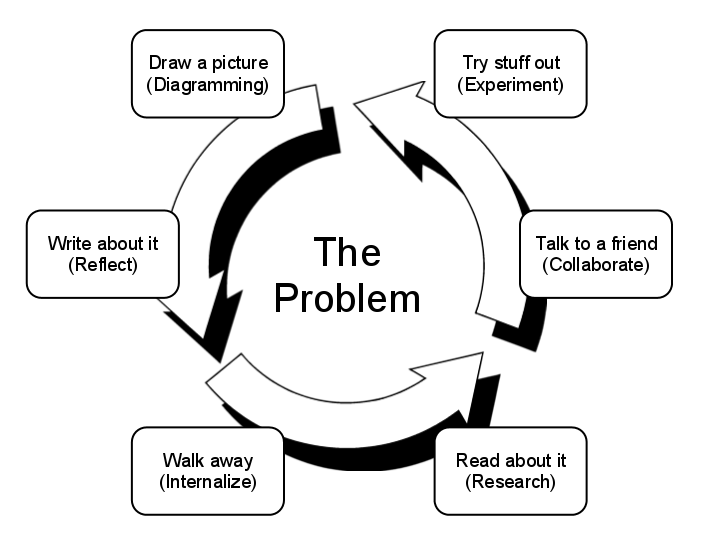Problem solving in life is rarely a linear process. In fact, when I think about how I solve problems, I find myself using something like the following process.

I try out different strategies for solving the problem, but I don’t start with the same strategy all the time, nor do I follow the same steps. Often I’ll skip some of the strategies above, and I very rarely spend the same amount of time working on each step.
The walk-away step I discovered after I finished school. I realized that I would often solve problems at unexpected times, either when my mind was focused in other areas, or unfocused completely. This is not a uncommon occurence, I have read about and talked to many people who note that the solution to problems came to them in similar circumstances.
How do we teach students about the importance of walking away from a perplexing problem sometimes? Can we trust them to walk away but come back to the problem? How do we show them that problem solving is not a linear process? How can we impart the difference between collaborating with someone else on the solution to a problem, and relying on others to solve problems for us?

Alfonso Gonzalez says:
It seems to me that the best way we can help our students learn and become problem solvers is to give them plenty of practice. Instead of always giving them the answers, we need to let them solve problems as they arise as well as problems we design for them.
The next step is to provide feedback. The nice thing about problem solving is that it should be pretty simple to know if you’ve successfully solved the problem or not! :o)
August 22, 2011 — 3:49 pm
David Wees says:
I don’t think that is true actually. For really good and deep problems, it can be hard to see if you’ve solved them. In fact, that is part of what makes them interesting. I think feedback is important, but not so much that we define solutions for our students.
August 22, 2011 — 3:59 pm
Shawn Urban says:
Hi David,
I too experience the “walk away” step of problem solving, though it is not just confined to problem solving. I often walk away when I am writing something or painting or even walking literally through a forest or along a trail and thinking about the ecology that I am witnessing. Often I work on two to three projects at a time, dropping and picking them up when my mind fills with each. This seems to work well for me.
Just off the top of my head, in response to your last paragraph, getting students to reflect on their thinking process as part of the assignment allows you to “view” that process. And getting them to record these thoughts in project wikis allows you to view when they make changes, giving you the walk away and return times of each student, or at least when they contribute to the wiki.
Take a look at David Pimm’s Math lab to see how he did this in that lab.
Thank you for the great post.
Shawn
August 22, 2011 — 10:16 pm
Jan Robertson says:
It’s important that we encourage them to be metacognitive, so that they can balance knowing when to persist with a problem with knowing when to walk away thus letting the problem percolate in their brains.
One of the more important questions (imho) is how do we build into our programs “walk away” time?
I would prefer that I see the problem solving, start to finish, done at school, because otherwise students come back to me with mom or dad’s solution, not their own, and the smarter ones can mimic the right language to almost make it sound like they know what they’re talking about, but deeper probing usually reveals that they’ve just been “told” the answer or “well, my mom helped me by telling me to blah blah blah.
I’d love to give students walk away time… but I don’t want them walking home to the answers being handed to them. 🙁
There’s also such HUGE diversity in a classroom… there’s a limit to how many extra activities or extensions or “do this while we wait for others to finish” kinds of activities one can assign! Some groups will finish in 20 minutes, some will take three days IF you let them… that presents challenges as well.
Thanks for the thought provoking question. I completely agree that it’s a necessary strategy, but… am still looking for answers myself. 🙂
August 24, 2011 — 11:44 pm